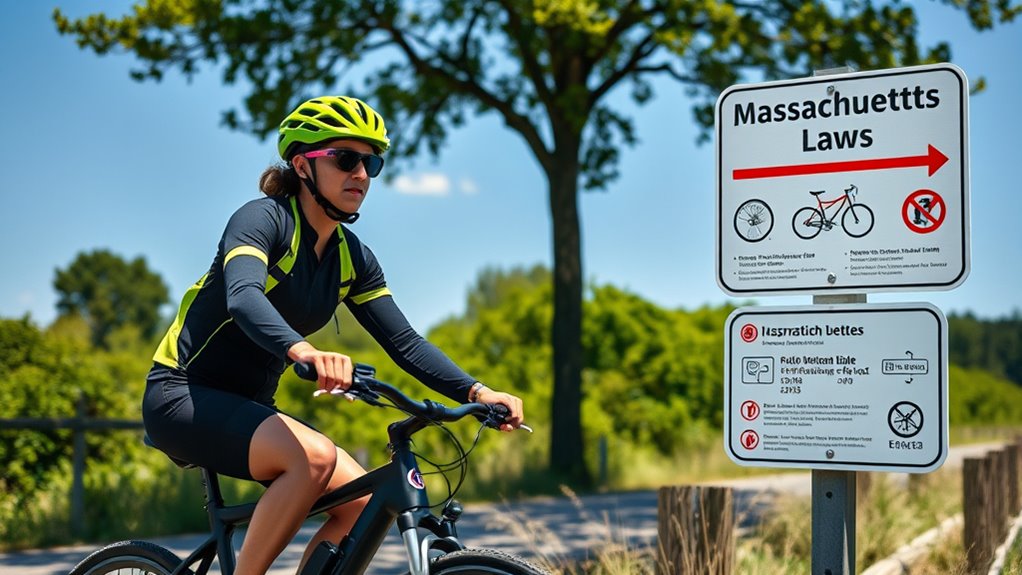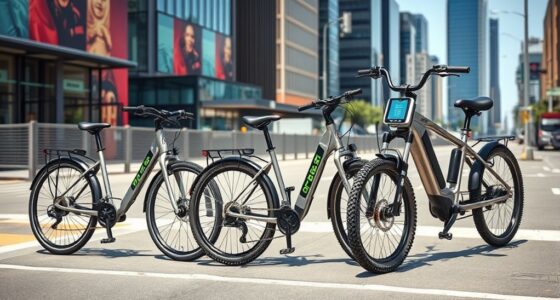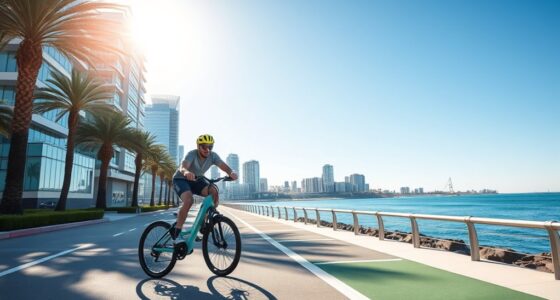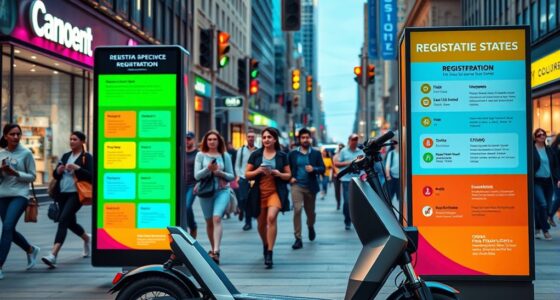In Massachusetts, e-bike laws for 2025 categorize bikes into Class 1, 2, and 3, with different speed limits and features like throttle and pedal assist. You need to know where you can ride, especially since Class 3 bikes often require registration and accessories like helmets. Most Class 1 and 2 models don’t need registering, but staying compliant is essential. To navigate these rules and guarantee you ride safely, keep exploring the details ahead.
Key Takeaways
- Massachusetts classifies e-bikes as Class 1, 2, and 3, with specific speed and assist limitations affecting where you can ride.
- Most Class 1 and 2 e-bikes do not require registration, but Class 3 models may need RMV registration and a helmet.
- Helmets are mandatory for riders under 18; recommended for all riders for safety.
- Use lights, reflective clothing, and obey traffic laws to ensure safe and legal e-bike operation.
- Stay updated on evolving Massachusetts e-bike laws to ensure compliance and safe riding practices in 2025.

Are you unsure about where you stand with e-bike regulations in Massachusetts? It’s common to feel uncertain given the evolving laws surrounding e-bikes. The state has taken steps to clarify requirements, especially around bike safety and e-bike registration, so riders can enjoy their bikes confidently and legally. Understanding these regulations is essential to avoid fines or penalties and to guarantee a safe riding experience.
Massachusetts classifies e-bikes into three categories based on their speed and motor power. Class 1 e-bikes provide pedal assistance up to 20 mph, with no throttle use. Class 2 e-bikes also max out at 20 mph but include a throttle, making it easier to start and maintain speed without pedaling. Class 3 e-bikes assist up to 28 mph and are often equipped with a speedometer. Knowing your e-bike’s classification helps determine where and how you can ride, so always check your bike’s specs.
Massachusetts e-bike classes: pedal assist up to 20 mph, throttle included, and assist up to 28 mph.
Bike safety remains a top priority under Massachusetts law. Riders are required to wear a helmet if they’re under 18, but it’s strongly recommended for everyone. Proper safety gear, like reflective clothing and lights, enhances visibility, especially during dawn, dusk, or nighttime rides. Riding predictably and obeying traffic laws, just like traditional cyclists, is essential to prevent accidents. It’s also wise to familiarize yourself with local bike lanes and rules of the road to stay safe and avoid conflicts with vehicles or pedestrians. Additionally, maintaining your e-bike’s condition, including brakes and tires, can significantly improve your safety while riding.
One key aspect of Massachusetts e-bike regulations is e-bike registration. Unlike traditional bicycles, some e-bikes—particularly those with higher speeds or more powerful motors—may need to be registered with the Massachusetts Registry of Motor Vehicles (RMV). Currently, most Class 1 and 2 e-bikes don’t require registration, but if you own a Class 3 e-bike or one that exceeds certain power limits, registration could be necessary. Registering your e-bike helps authorities track ownership, guarantees compliance, and can be essential if your bike is stolen or involved in an incident. It’s a straightforward process that involves providing proof of purchase and paying a small fee.
The laws are designed to promote safe and legal riding, but they also empower you as a rider. Staying informed about e-bike registration requirements and practicing bike safety can make your experience more enjoyable and secure. Massachusetts continues to update its laws, so it’s a good idea to check regularly for any changes. By understanding your responsibilities and respecting the rules, you can ride confidently, knowing you’re doing your part to keep yourself and others safe on Massachusetts roads. Being aware of e-bike classifications and their specific regulations can help ensure you stay compliant with current laws.
Frequently Asked Questions
Are E-Bikes Allowed on All Public Trails in Massachusetts?
You can’t ride your e-bike on all public trails in Massachusetts. Check trail signage first, as some areas restrict e-bike use based on local rules. E-bike classifications matter too—Class 1 and 2 bikes are generally permitted on many trails, but Class 3 bikes often face restrictions. Always verify trail-specific regulations before riding to make sure you’re complying with local laws and respecting signage.
What Are the Age Restrictions for E-Bike Riders?
You can start riding your e-bike at age 16, but don’t forget that helmet safety is essential — it’s a must for all riders under 18. No bike licensing is required for e-bikes, but age restrictions are strict to protect young riders. If you’re under 16, you’ll need a guardian’s permission and must follow safety rules. Always prioritize safety gear and stay within legal age limits.
Do E-Bike Laws Vary Between Massachusetts Cities and Towns?
Yes, e-bike laws can vary between Massachusetts cities and towns due to local regulations and enforcement variations. You should check specific city or town rules, as some areas may have stricter speed limits, helmet requirements, or restrictions on where you can ride. Local authorities handle enforcement differently, so staying informed about these differences helps you ride legally and safely across different communities. Always review local regulations before hitting new areas.
Are There Specific E-Bike Helmet Requirements in Massachusetts?
In Massachusetts, helmet safety is a top priority, especially since 85% of e-bike accidents involve head injuries. You’re required to wear a helmet that fits properly and meets safety standards whenever you ride. This protective gear reduces your risk of serious injury and is mandatory for riders under 18. Always choose a helmet designed for cycling, and make sure it stays securely in place for safe and enjoyable riding.
How Do Massachusetts E-Bike Laws Compare to Neighboring States?
In Massachusetts, e-bike laws are stricter than some neighboring states, often requiring state licensing for certain classes and restricting access to bike lanes for higher-speed models. You need to be aware that, unlike Vermont or New Hampshire, Massachusetts enforces these regulations more vigorously, so make sure you’re properly licensed and know where you can ride your e-bike. This guarantees safety and compliance while enjoying your ride across state lines.
Conclusion
Understanding Massachusetts e-bike laws guarantees you ride safely and legally. Did you know that e-bike sales have increased by over 30% in the past year? This surge highlights how more riders are embracing eco-friendly transportation. Staying informed about laws helps you avoid fines and stay safe on the road. So, gear up, follow the rules, and enjoy the ride—your responsible riding makes a difference in your community and the environment.









